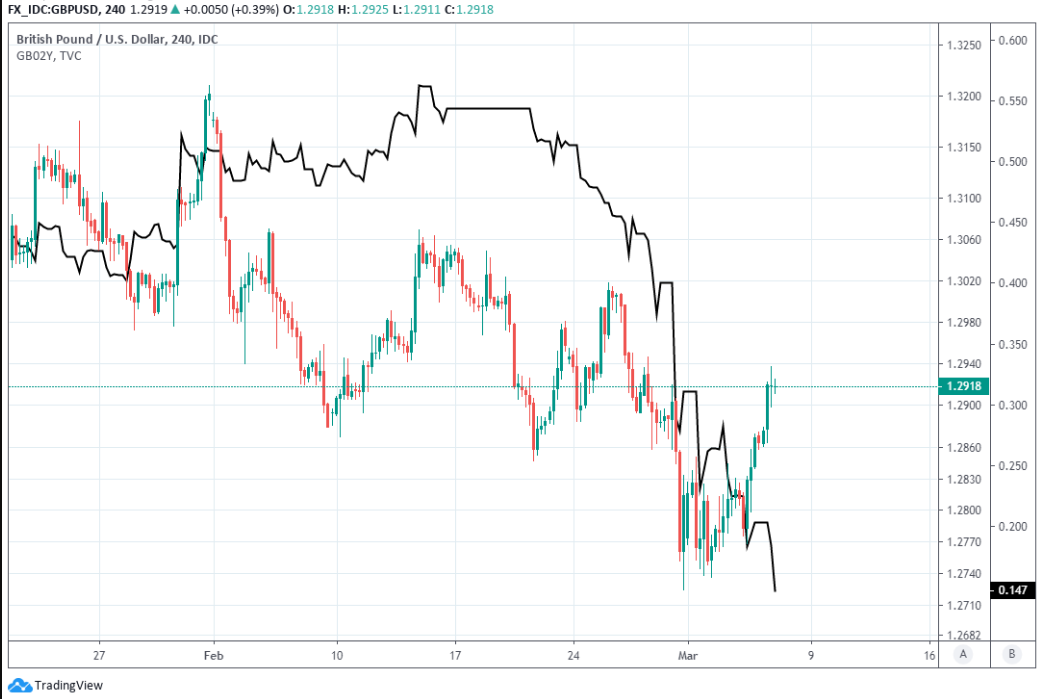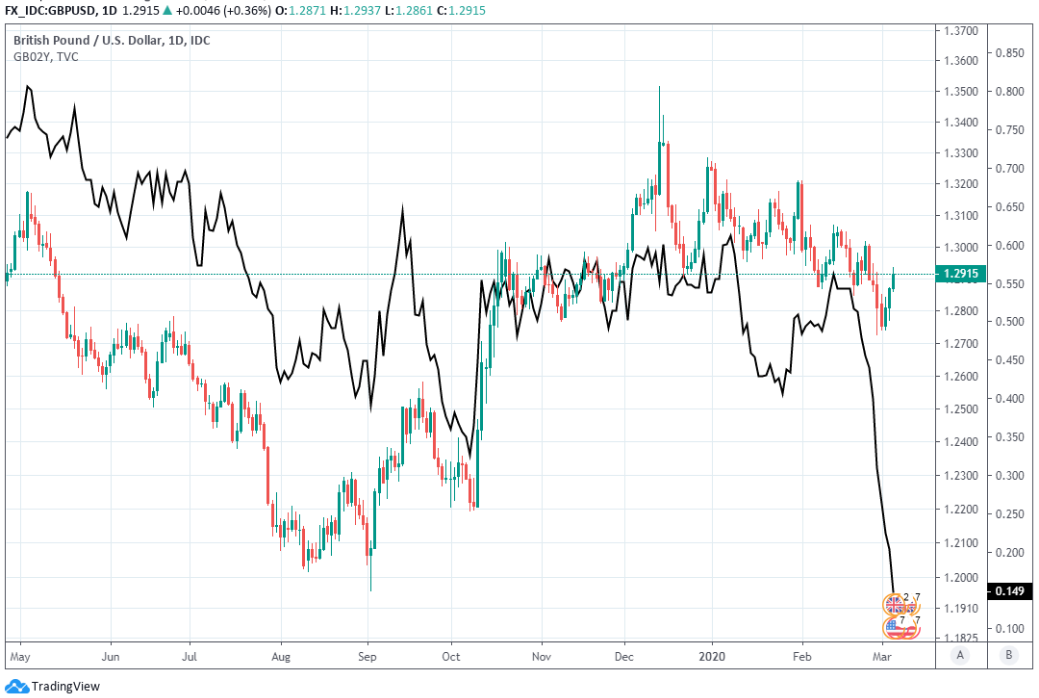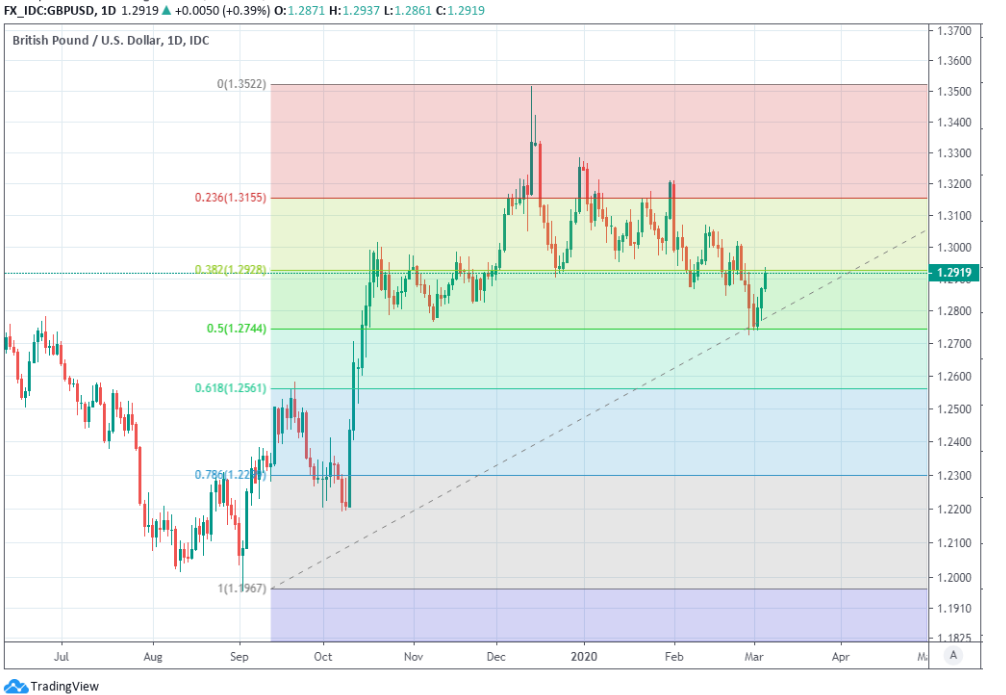The Pound-to-Dollar Rate is Lifted by Steady Hand of the BoE but Rate Cuts are Coming, Analysts Say
- Written by: James Skinner
-
- GBP/USD lifted above 1.29 by steady hand of the BoE.
- After Bailey says wants evidence of virus impact to cut.
- But market sees virus impact coming, rate cuts in March.
- MUFG says BoE wait offers only short-lived support to GBP.
- Goldman Sachs eyes possible 0.5% BoE cut on March 26.
- Deutsche Bank sees 0.25% cut, adapted March 11 budget.
- Commerzbank says GBP outlook negative below 1.3005.

Image © Adobe Images
- GBP/USD Spot rate: 1.2921, up +0.39% today
- Indicative bank rates for transfers: 1.2568-1.2658
- Transfer specialist indicative rates: 1.2726-1.2804 >> Get your quote now
The Pound-to-Dollar reclaimed the 1.29 handle Thursday as the steady hand of the Bank of England (BoE) lifted the British currency off multi-month lows although analysts say the central bank's patience will soon run out and that Sterling could come under pressure again.
Pound Sterling was higher against all major rivals other than the safe-haven Japanese Yen and the Euro on Thursday after incoming BoE Governor Andrew Bailey told parliament the bank wants evidence of a coronavirus impact on the economy before it takes action, dispelling market fears about a possible imminent cut to Bank Rate.
Sterling was also buoyed when negotiator Michel Barnier said that Brexit negotiations got off to a "constructive" start this week, after a weeks long period in which each set out their respective stalls and it became clear the two sides are far apart in their objectives for the talks. Barnier said this remained the case after another round of cordial talks, with the so-called ‘level playing’ field demand an early roadblock to progress.
"Given the risks that the BoE will cut rates this month, the pound’s respite could be temporary. Another factor for the GBP outlook is the talks between the EU and the UK on their post-Brexit relationship. These finally started in Brussels on Monday after several weeks of posturing on both sides," says Jane Foley, a strategist at Rabobank. “The threat made by PM Johnson that he would be prepared to walk away from the talks and open the UK to WTO rules on trade at the start of next year, is likely to keep GBP investors worried. For this reason we expect GBP/USD to trade mainly below 1.30 on both a 1 and 3 month view.”
Lingering concerns about a ‘no deal’ Brexit from the transition period at year-end could remain a concern for the Pound in the months ahead, even though the potential adverse economic effects of tariffs in 2021 are dwarfed by those stemming from the spread of coronavirus in all of the world's major economies given the disruption to the ordinary course of business that follow efforts to contain it on the part of governments and increasingly, the public.
Above: Pound-to-Dollar rate at 4-hour intervals with two-year GBP government bond yield (black) at lowest since 2017.
New confirmed coronavirus cases grew faster outside of the four major outbreak centres on Wednesday than they did inside, indicating that the epidemic may be broadening. There were 552 new cases outside of China, South Korea, Italy and Iran on Wednesday, more than double the previous day's 258, according to Pantheon Macroeconomics analysis of data based on government disclosures.
"The trend is still rising and the outbreak is accelerating outside the big four," says Ian Shepherdson, chief economist at Pantheon Macroeconomics. "The broadening of the global outbreak outside the big four is disconcerting, and the patterns seen in the initial outbreaks suggests that yesterday’s dip in the total number of worldwide new cases will prove temporary."
Coronavirus is now spreading rapidly in more than 70 countries across the globe including the world’s most developed economies and hubs of global finance, as well as the world’s poorest and least developed countries. And with the not-pandemic said by governments to be only at its beginning, the prospect of public panic, self-isolation and possible even state-enforced isolations on the rise, the threat to the global economy is growing larger by the day.
UPDATE on coronavirus (#COVID19) testing in the UK:
— Department of Health and Social Care (@DHSCgovuk) March 5, 2020
Today's figures will be published later this afternoon.
We are working hard to provide you with the latest information and will tweet this out as soon as possible.
Central banks have sprung into action in some parts of the globe in order to provide reassurance to households, companies and investors who’d jettisoned risk assets like stocks and commodities from their portfolios en masse in prior weeks. The Federal Reserve announced a surprise 50 basis point rate cut on Tuesday, taking the top of the Federal Funds range down to 1.25%, while the Bank of Canada followed suit with a 50 point cut to 1.25% Wednesday. And the markets had been waiting for the Bank of England to join in.
“There had been some market chatter that the BoE was preparing to lower rates yesterday morning but it proved unfounded. Then in the afternoon, new Governor-in-waiting Andrew Bailey who is set to take over from Mark Carney on the 16th March put a further dampener on expectations for an immediate policy response,” says Derek Halpenny, head of research, global markets EMEA and international securities at MUFG. “If the BoE waits to deliver easing until later this month, it could encourage a firmer pound in the very near-term but we doubt it will last on that basis alone with policy action on the way. “
Above: Pound-to-Dollar rate shown at daily intervals with two-year GBP government bond yield (black) at lowest since 2017.
The Fed’s rate cut has obliterated much of the Dollar’s yield advantage over other currencies and incoming BoE Governor Andrew Bailey’s suggestion on Wednesday that the Bank might wait a while before cutting its own rate has provided a tailwind to the Pound-to-Dollar rate this week.
But analysts and economists are increasingly of the view that the BoE will cut rates no later than the March 26 meeting and the two-year British government bond yield fell to 0.147% on Thursday, it's lowest since 2017, giving the impression that investors are banking on Bank Rate heading toward zero.
A large rate cut could see the gap between British and U.S. rates rewiden to earlier levels. There was 100 basis points between the two cash rates until the Fed cut on Tuesday, when the 'spread' fell to 50 basis points.
"We expect the Monetary Policy Committee (MPC) to ease policy at its March meeting, given the likely economic hit from the virus outbreak and the turn towards global monetary easing.1 We continue to think a 50 basis points (bp) cut at the March 26 meeting is most likely, although a smaller move is possible," says Sven Jari Stehn, head of Europe economics at Goldman Sachs. "We expect the coronavirus outbreak to push the UK economy to the brink of recession in coming months. Although the post-election surveys have bounced back notably, underlying momentum (especially in the “hard” data) has remained weak coming into the virus outbreak. Real GDP was flat in Q4.”
Pricing in the overnight-index-swap market suggests investors expect one 25 basis point rate cut at Andrew Bailey’s first meeting on March 26, so if the Bank goes ahead and cuts by the 50 basis points that Goldman Sachs is looking for then Sterling could suffer as a result.
Above: Pound-to-Dollar rate shown at daily intervals with Fibonacci retracement of September 2019 uptrend market out.
Both Goldman Sachs and Deutsche Bank told clients this week the coronavirus will hit UK growth in the months ahead and that the government will likely adapt next week's budget to include measures aimed at supporting companies and households as they grapple with the virus fallout.
“We now see the UK economy growing by 0.5% in 2020 as a result of weaker global growth, supply side disruptions, and a hit to demand due in part to subdued sentiment and self-containment measures," says Sanjay Raja, an economist at Deutsche Bank. "We expect next week's Spring Budget to highlight a series of emergency fiscal measures to support businesses and households as a result of disruptions caused by the coronavirus."
The government was expected to set out on March 11 a spending plan that provides extra cash for investments designed to get the economy growing faster, and those likely spending plance were once a meaningful tailwind for the Pound because they were seen staving off a BoE rate cut at least until mid-year.
But the economy now looks set to suffer and rates be lowered no matter what's announced in the budget. And appetite for the Pound could prove fleeting if the virus truly takes hold in the UK, and doing so leaves the budget looking like an inadequate plaster rather than a form of stimulus.
Both Goldman and Deutsche Bank expect rate cuts from the Bank of England in March in response to the threat posed by coronavirus. Confirmed cases rose to 90 in the UK on Thursday, the Telegraph reported, and the government is moving to a new stage in its strategy to deal with the virus. Meanwhile the Chief Medical Officer has said that there is “ongoing transmission” in the UK, indicating that infection numbers could rise sharply in the weeks ahead.
“GBP/USD continues to sit on the 50% retracement at 1.2736 and the 200 day moving average at 1.2700 and we would allow for a near term rebound towards the downtrend currently at 1.2995. A close below 1.2700 will likely act as the catalyst for a break lower and would target 1.2291/1.2194 (October low). The outlook stays negative while capped by the 55 day moving average at 1.3005 and the short term downtrend at 1.2995,” says Karen Jones, head of technical analysis for currencies, commodities and bonds at Commerzbank.







